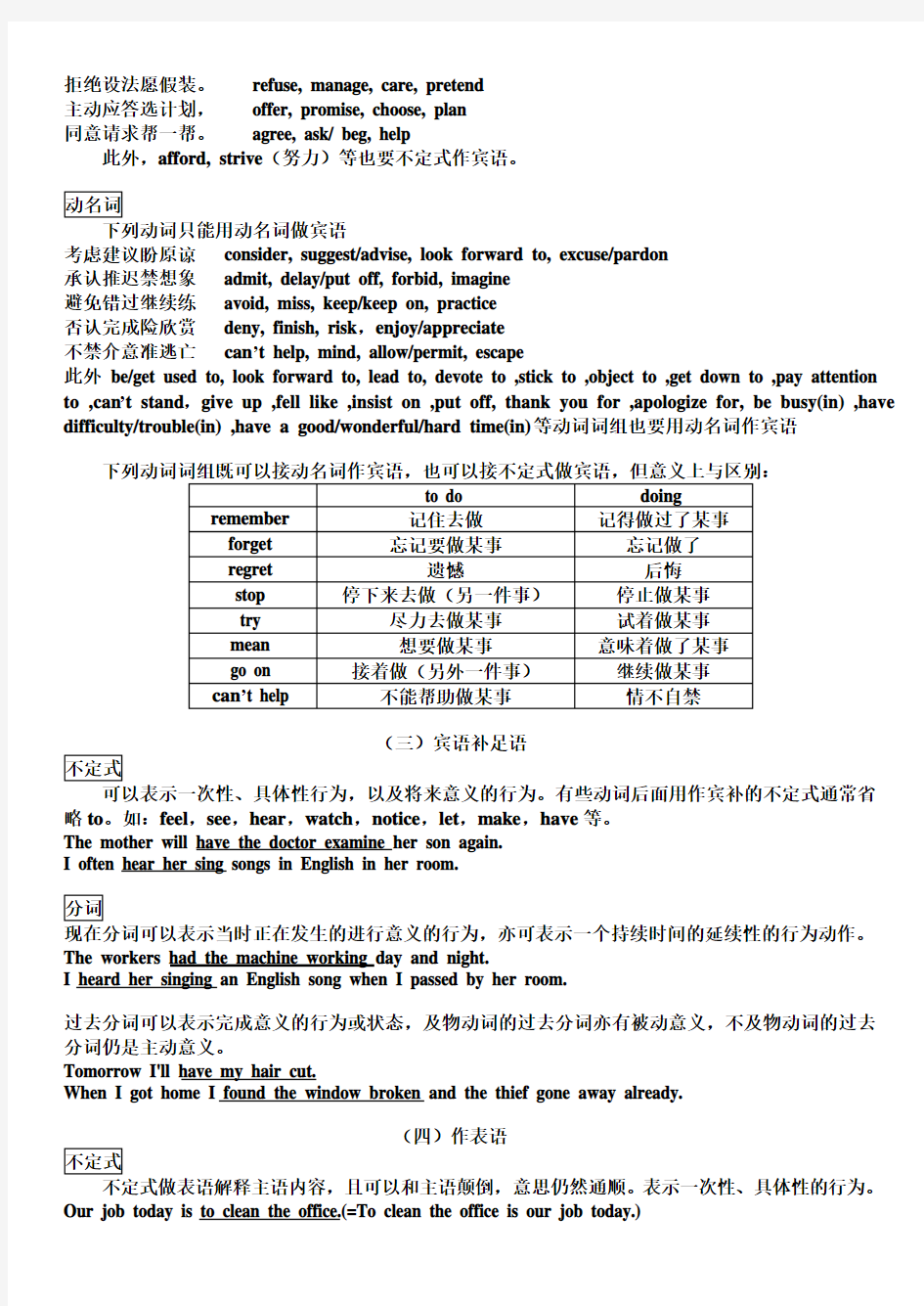

非谓语动词讲义
一、非谓语动词定义
在英语中,不能作句子谓语,而是担任其他语法功能的动词,叫作非谓语动词。
二、非谓语动词形式及其功能
非谓语动词有3种形式:动词不定式,动名词和分词(含现在分词和过去分词)。
三.根据语法功能看非谓语动词的用法
(一)作主语
懂一点英语是一回事,掌握英语完全是另一回事。
通常用it做形式主语
1.It + be + adj. + to do It’s important for us to learn English.
2.It + be + n. + to do It’s a shame to behave like that.
3.It + v. + (宾语) + to do It takes an exceptional teacher to cope with a student like
that.
4.It + be + prep. phr. + to do It is not within my power to answer the question.
通常用it做形式主语
1.It’s +adj. +doing It’s useless arguing about that.
2.It’s + n. + doing It’s no use/no good arguing about that.
3.There is后有时可以跟动名词做主语There is no denying that he is bad-tempered.
动名词:表示客观性、一般性行为不定式:表示一次性、具体性行为(见ppt)
(二)作宾语
决心学会想希望,decide/determine, learn, want, expect/hope/wish,
拒绝设法愿假装。refuse, manage, care, pretend
主动应答选计划,offer, promise, choose, plan
同意请求帮一帮。agree, ask/ beg, help
此外,afford, strive(努力)等也要不定式作宾语。
考虑建议盼原谅consider, suggest/advise, look forward to, excuse/pardon
承认推迟禁想象admit, delay/put off, forbid, imagine
避免错过继续练avoid, miss, keep/keep on, practice
否认完成险欣赏deny, finish, risk,enjoy/appreciate
不禁介意准逃亡can’t help, mind, allow/permit, escape
此外be/get used to, look forward to, lead to, devote to ,stick to ,object to ,get down to ,pay attention to ,can’t stand,give up ,fell like ,insist on ,put off, thank you for ,apologize for, be busy(in) ,have difficulty/trouble(in) ,have a good/wonderful/hard time(in)等动词词组也要用动名词作宾语
(三)宾语补足语
略to。如:feel,see,hear,watch,notice,let,make,have等。
The mother will have the doctor examine her son again.
I often hear her sing songs in English in her room.
The workers had the machine working day and night.
I heard her singing an English song when I passed by her room.
过去分词可以表示完成意义的行为或状态,及物动词的过去分词亦有被动意义,不及物动词的过去分词仍是主动意义。
Tomorrow I'll have my hair cut.
When I got home I found the window broken and the thief gone away already.
(四)作表语
意思仍然通顺。表示一次性、具体性的行为。Our job today is to clean the office.(=To clean the office is our job today.)
分词做表语表明主语的性质、特征和状态,不能和主语颠倒,可以回答how的问题。
The news is very exciting. (How is the news?)
The children are well dressed these days.
动名词做表语解释主语内容,且可以和主语颠倒,意思仍然通顺,回答what的问题。表示经常性、一般性的行为。
Her job is cleaning offices. (What is her job?) (Cleaning offices is her job.)
(五)作定语
主谓和解释先行词内容等关系。在时态上常是将来意义。此外,不定式做定语时只能后置,不可前置。
1. Please find a man to help us. Today I have a letter to write.
不定式如果是不及物动词或不定式所修饰的名词或代词是不定式动作的地点、工具等,后需有相应的介词。
Here is some paper for you to write on. He has a comfortable house to live in.
不定式所修饰的名词如果是time, place, way时,不定式后面的介词通常省去。
He had no money and no place to live (in). We found a way to solve this problem (in).
2. 不定式作定语用作主动语态和被动语态的意义不同
Have you anything to send? Have you anything to be sent (by me or by others)?
4.不定式表将来I borrowed some books to read during the holiday.
5. 用来修饰被序数词、最高级或no, all, any等限定的中心词
He was the best man to do the job.
可前置,分词短语做定语则须后置。
doing表示主动进行The woman standing over there is our teacher. falling leaves 正落的叶子done表示被动完成I like reading books written by Lu Xun. fallen leaves落下的叶子
The house to be built (=which will be built/which is to be built) next year will be our new library.
The house being built (=which is being built) now will be our new library.
The house built (=which was built) last year is our new library now.
特征和状态。 a flying suit a climbing shoes a sleeping car
动名词做定语 a swimming pool = a pool for swimming
现在分词做定语 a swimming boy = a boy who is swimming
判断方式:动名词和被修饰词之间是介宾关系,表用途;分词做定语看能否构成主谓关系
(六)做状语
He sat down to have a rest. (表目的)
To find out more about university courses, call (920) 746-3789. (见ppt)
He got up early in order to /so as to catch the first bus. (表目的, so as to通常不用于句首)
He woke up only/just to find everybody gone.(表结果)(见ppt)
Peter’s cellphone was left in a taxi by accident, never to be found again.
*不定式作原因状语往往用于形容词之后,这些形容词通常是happy, sorry, fortunate, angry, glad, ashamed, discouraged, delighted, frightened, shocked等。
I am very glad to see you.(表原因)
He is old enough to go to school.(表程度)
分词放在句首表示时间、原因、条件、让步(见ppt)
*过去分词作时间状语表示的含义有两个: ①与谓语动词同时发生; ②被动意义。
When Seen from the top of the mountain, the city looks very beautiful with lights on at night. (表时间)
Unless invited to speak, you should remain silent at the conference. (表条件)
Although told to stop, Peter went on talking about his favorite singer. (表让步)
Faced with a difficult situation, I decided to ask my boss for advice. (表原因)
*现在分词作时间状语一般位于句首,表示的动作和谓语动词的动作同时发生
Arriving (=When he arrived) at the bus stop, he found his sister there.
*如果分词动作发生在谓语动词之前,用现在分词的完成体形式(having done/ been done)。Having (=When he had) finished his homework, he went to bed. (见ppt)
分词放在句尾表示伴随情况,补充说明,结果状语, 表示谓语动词正在所处主动或被动的状态The father came in, followed by his son. (伴随情况)
They walked along the streets, talking and laughing. (伴随情况)
After his journey from abroad, Richard returned home, exhausted. (补充说明)(见ppt)
连词+doing/done结构作状语. 这些连词有: when, while, if, though, unless,once
When first introduced to the market, these products enjoyed great success.
Though told to stop, he went on talking about his favorite singers.
独立主格结构
分词短语所表示的动作的逻辑主语一般和句子的主语一致;但有的分词短语有它自己的独立的主语(在分词短语之前), 这种主语常常是名词或代词(主格), 这种结构叫做独立主格结构, 只能用作状语。(见ppt)
1.There being no bus, we had to walk home. = Because there was no bus, we had to walk home.
2.She being ill, her daughter stayed at home to take care of her.
3.The signal given, the train started. = After the signal was given, the train started.
有时也可用“with (或without) + 名词(或代词宾格)+分词”的结构表示伴随情况。
The boy returned, (with) his nose bleeding.
有时, 独立主格结构中也用动词不定式.
I send you 100 dollars today, the rest to follow in a year.
四、非谓语动词的否定结构
非谓语动词的否定结构都是在它们前面加not来构成的。
They decided not to go.
Tom’s not passing the exam made his father very angry.
Not having finished his homework, the boy ran out to play football.